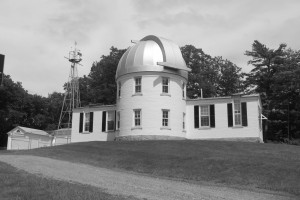Bellow the tree line of College Park sits one of The College’s most historic of buildings, the Shattuck Observatory, which has been a fixture in Hanover since it’s construction in 1854. This quaint building was designed by Lebanon native Ammi B. Young and G.J.F. Bryant, a famous architect in the Boston area. Young’s brother, Professor Ira Young ‘1828, was the mastermind behind the movement to build an observatory as he pressed the trustees of The College to acquire new equipment for astronomical equipment. With the construction of the observatory, a new age of science had dawned in Hanover. For the first time ever, Meteorology was offered as a course of study in the 1849-1850 academic year. Once the observatory was completed, it became a central place on campus not only to study the final frontier, but also to observe the weather patterns of New Hampshire.
Dr. George C. Shattuck ‘1803 was the man who made the observatory’s construction possible. With his generous gift of $7,000, he helped front a project that would eventually be supported by the trustees as well to make an improvement to the school that was small in stature, but monumental in impact. The Observatory is one of the first major investments that The College would make in the sciences.
Historically, Shattuck is very significant amongst the community of astronomical research. The Observatory is the oldest scientific building on campus; born out of an explosion of interest in astronomy across the country and is one of three structures built during this time that still operates at the original plant.
The Shattuck Observatory is known to generations of Dartmouth men and women as a landmark on Campus. However, researchers have quietly collected meteorological data for the Smithsonian Institution since 1853. With few exceptions, data collection has continued up until today. The observatory is still a volunteer observation station for the National Weather Service.
In a recent event, the safety of the observatory had been threatened by a possible project to build a 750-bed dormitory in College Park. This project threatened the last “dark sky” location in central campus, putting the long standing meteorological records at risk. However, in an act of courage and defiance, the Dartmouth community spoke out against this atrocity, making it clear that the Observatory would not be compromised.
Today, the Observatory continues to operate and is partially run by student groups interested in astronomy and meteorology. The observatory still has public viewing nights available to students, faculty, alumni, and anyone interested in astronomy. Public observation takes place in at the North Telescope in a building just beyond the main dome. To this day, people of all walks of life within the Dartmouth community and the Upper Valley area gather at Shattuck to see what Young and Dr. Shattuck had pursued over 150 years ago.


Be the first to comment on "Patriarchy: the Shattuck Observatory"